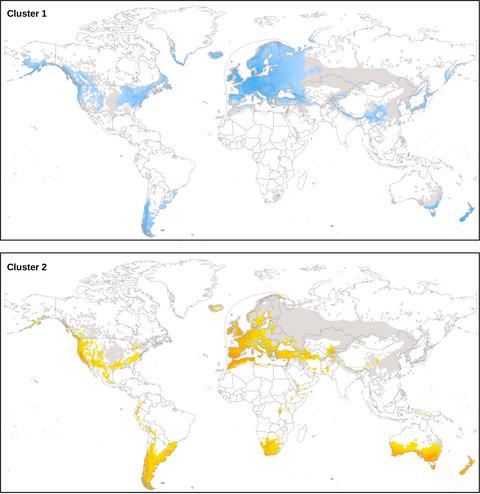当前位置:
X-MOL 学术
›
Ecol. Evol.
›
论文详情
Our official English website, www.x-mol.net, welcomes your
feedback! (Note: you will need to create a separate account there.)
Geographical pattern of genetic diversity in Capsella bursa‐pastoris (Brassicaceae)—A global perspective
Ecology and Evolution ( IF 2.3 ) Pub Date : 2020-11-13 , DOI: 10.1002/ece3.7010 Christina Wesse 1 , Erik Welk 2 , Herbert Hurka 1 , Barbara Neuffer 1
Ecology and Evolution ( IF 2.3 ) Pub Date : 2020-11-13 , DOI: 10.1002/ece3.7010 Christina Wesse 1 , Erik Welk 2 , Herbert Hurka 1 , Barbara Neuffer 1
Affiliation

|
We analyzed the global genetic variation pattern of Capsella bursa‐pastoris (Brassicaceae) as expressed in allozymic (within‐locus) diversity and isozymic (between‐locus) diversity. Results are based on a global sampling of more than 20,000 C. bursa‐pastoris individuals randomly taken from 1,469 natural provenances in the native and introduced range, covering a broad spectrum of the species’ geographic distribution. We evaluated data for population genetic parameters and F‐statistics, and Mantel tests and AMOVA were performed. Geographical distribution patterns of alleles and multilocus genotypes are shown in maps and tables. Genetic diversity of introduced populations is only moderately reduced in comparison with native populations. Global population structure was analyzed with structure, and the obtained cluster affiliation was tested independently with classification approaches and macroclimatic data using species distribution modeling. Analyses revealed two main clusters: one distributed predominantly in warm arid to semiarid climate regions and the other predominantly in more temperate humid to semihumid climate regions. We observed admixture between the two lineages predominantly in regions with intermediate humidity in both the native and non‐native ranges. The genetically derived clusters are strongly supported in macroclimatic data space. The worldwide distribution patterns of genetic variation in the range of C. bursa‐pastoris can be explained by intensive intra‐ and intercontinental migration, but environmental filtering due to climate preadaption seems also involved. Multiple independent introductions of genotypes from different source regions are obvious. “Endemic” genotypes might be the outcome of admixture or of de novo mutation. We conclude that today's successfully established Capsella genotypes were preadapted and found matching niche conditions in the colonized range parts.
中文翻译:

荠菜(十字花科)遗传多样性的地理格局——全球视角
我们分析了荠菜(十字花科)的全球遗传变异模式,以异酶(基因座内)多样性和同工酶(基因座间)多样性表示。结果基于对 20,000 多个毕赤酵母个体的全球抽样,这些个体随机取自本地和引进范围的 1,469 个自然种源,涵盖了该物种的广泛地理分布。我们评估了群体遗传参数和F统计数据,并进行了 Mantel 检验和 AMOVA。等位基因和多位点基因型的地理分布模式显示在地图和表格中。与本地种群相比,引入种群的遗传多样性仅略有降低。使用结构分析全球种群结构,并使用物种分布模型通过分类方法和宏观气候数据独立测试所获得的聚类隶属关系。分析揭示了两个主要集群:一个主要分布在温暖干旱至半干旱气候地区,另一个主要分布在温带湿润至半湿润气候地区。我们观察到这两个谱系之间的混合主要发生在本地和非本地范围内具有中等湿度的地区。遗传衍生的簇在宏观气候数据空间中得到了强有力的支持。毕赤酵母范围内遗传变异的全球分布模式可以通过密集的洲内和洲际迁徙来解释,但似乎也涉及气候预适应引起的环境过滤。来自不同来源地区的基因型的多次独立引入是显而易见的。 “地方性”基因型可能是混合或从头突变的结果。我们的结论是,今天成功建立的荠菜基因型已被预先适应,并在定植范围部分找到了匹配的生态位条件。
更新日期:2021-01-08
中文翻译:

荠菜(十字花科)遗传多样性的地理格局——全球视角
我们分析了荠菜(十字花科)的全球遗传变异模式,以异酶(基因座内)多样性和同工酶(基因座间)多样性表示。结果基于对 20,000 多个毕赤酵母个体的全球抽样,这些个体随机取自本地和引进范围的 1,469 个自然种源,涵盖了该物种的广泛地理分布。我们评估了群体遗传参数和F统计数据,并进行了 Mantel 检验和 AMOVA。等位基因和多位点基因型的地理分布模式显示在地图和表格中。与本地种群相比,引入种群的遗传多样性仅略有降低。使用结构分析全球种群结构,并使用物种分布模型通过分类方法和宏观气候数据独立测试所获得的聚类隶属关系。分析揭示了两个主要集群:一个主要分布在温暖干旱至半干旱气候地区,另一个主要分布在温带湿润至半湿润气候地区。我们观察到这两个谱系之间的混合主要发生在本地和非本地范围内具有中等湿度的地区。遗传衍生的簇在宏观气候数据空间中得到了强有力的支持。毕赤酵母范围内遗传变异的全球分布模式可以通过密集的洲内和洲际迁徙来解释,但似乎也涉及气候预适应引起的环境过滤。来自不同来源地区的基因型的多次独立引入是显而易见的。 “地方性”基因型可能是混合或从头突变的结果。我们的结论是,今天成功建立的荠菜基因型已被预先适应,并在定植范围部分找到了匹配的生态位条件。











































 京公网安备 11010802027423号
京公网安备 11010802027423号